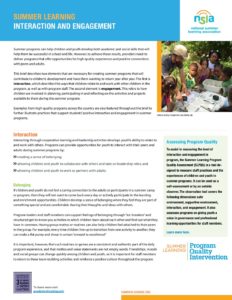

Summer programs can help children and youth develop both academic and social skills that will help them be successful in school and life. However, to achieve these results, providers need to deliver programs that offer opportunities for high-quality experiences and positive connections with peers and adults.
This brief describes two elements that are necessary for creating summer programs that will contribute to children’s development and have them wanting to return year after year. The first is interaction, which describes the ways that children relate to and work with other children in the program, as well as with program staff. The second element is engagement. This refers to how children are involved in planning, participating in and reflecting on the activities and projects available to them during the summer program.
Examples from high-quality programs across the country are also featured throughout the brief to further illustrate practices that support students’ positive interaction and engagement in summer programs.
see allDownload these helpful resources provided by partner organizations during NSLA’s Summer Solutions Leadership Series, November... read more
NSLA conducted a number of focus groups and in-depth interviews in September 2020 with 21... read more
This brief highlights the findings of a program quality assessment from a collaboration between the... read more
According to the RAND Corporation and Wallace Foundation report, Investing in Successful Summer Programs, summertime... read more